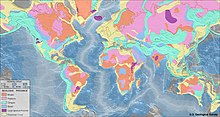From Wikipedia, the free encyclopedia

The Deccan Traps near Pune
Contents |
History
The Deccan Traps formed between 60 and 68 million years ago,[2] at the end of the Cretaceous period. The bulk of the volcanic eruption occurred at the Western Ghats (near Mumbai) some 65 million years ago. This series of eruptions may have lasted less than 30,000 years in total.[3]The original area covered by the lava flows is estimated to have been as large as 1.5 million km², approximately half the size of modern India. The Deccan Traps region was reduced to its current size by erosion and plate tectonics; the present area of directly observable lava flows is around 512,000 km2 (197,684 sq mi).
Effect on climate and contemporary life
The release of volcanic gases, particularly sulfur dioxide, during the formation of the traps contributed to contemporary climate change. Data points to an average drop in temperature of 2 °C in this period.[4]Because of its magnitude, scientists formerly speculated that the gases released during the formation of the Deccan Traps played a role in the Cretaceous–Paleogene extinction event (also known as the K–Pg extinction), which included the extinction of the non-avian dinosaurs. Sudden cooling due to sulfurous volcanic gases released by the formation of the traps and localised gas concentrations may have contributed significantly to mass extinctions. However, the current consensus among the scientific community is that the extinction was triggered by the Chicxulub impact event in Central America (which would have produced a sunlight-blocking dust cloud that killed much of the plant life and reduced global temperature, called an impact winter).[5]
Chemical composition
Within the Deccan Traps at least 95% of the lavas are tholeiitic basalts, however other rock types do occur:Mantle xenoliths have been described from Kachchh (northwestern India) and elsewhere in the western Deccan.
Fossils
The Deccan Traps are famous for the beds of fossils that have been found between layers of traps lava. Particularly well known species include the frog Oxyglossus pusillus (Owen) of the Eocene of India and the toothed frog Indobatrachus, an early lineage of modern frogs, which is now placed in the Australian family Myobatrachidae.[6][7] The infratrappean and intertrappean beds also contain fossil freshwater mollusks. [8]Theories of formation
It is postulated that the Deccan Traps eruption was associated with a deep mantle plume. The area of long-term eruption (the hotspot), known as the Réunion hotspot, is suspected of both causing the Deccan Traps eruption and opening the rift that once separated the Seychelles plateau from India. Seafloor spreading at the boundary between the Indian and African Plates subsequently pushed India north over the plume, which now lies under Réunion island in the Indian Ocean, southwest of India. The mantle plume model has, however, been challenged.[2]Data continues to emerge which supports the plume model. The motion of the Indian tectonic plate and the eruptive history of the Deccan traps show strong correlations. Based on data from marine magnetic profiles, a pulse of unusually rapid plate motion begins at the same time as the first pulse of Deccan flood basalts, which is dated at 67 Myr ago. The spreading rate rapidly increased and reached a maximum at the same time as the peak basaltic eruptions. The spreading rate then dropped off, with the decrease occurring around 63 Myr ago, by which time the main phase of Deccan volcanism ended. This correlation is seen as driven by plume dynamics.[9]
The Indian and African plates' motions have also been shown to be coupled, with the common element being the position of these plates relative to the location of the Réunion plume head. The onset of accelerated motion of India coincides with a large slowing of the rate of counterclockwise rotation of Africa. The close correlations between the plate motions suggest that they were both driven by the force of the Réunion plume.[9]



No comments:
Post a Comment